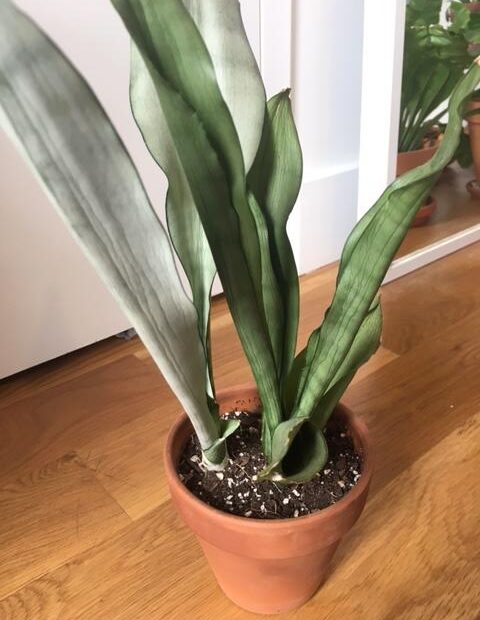The Snake Plant, a resilient and majestic species of flora, has captured the hearts of plant enthusiasts far and wide. With its striking luscious green leaves and its ability to thrive in low-light conditions, it has become a beloved addition to many indoor gardens. However, there comes a time when even the mightiest of plants faces an unexpected adversary—a puzzling and vexing issue that leaves both novices and experienced gardeners scratching their heads in dismay: Why is my Snake Plant wrinkly? In this article, we will unveil the mysterious nature of this enigma while exploring the potential causes behind those crinkled leaves. So brace yourself, horticultural detectives, as we embark on a quest to investigate the secrets of the Snake Plant’s wrinkles, meticulously dissecting the possible culprits behind this botanical conundrum.
Causes of Wrinkled Leaves in Snake Plants
Snake plants, also known as Sansevieria, are popular houseplants known for their durability and resilience. However, it can be concerning when you notice your snake plant’s leaves becoming wrinkled and droopy. There are several possible causes for this common issue, and understanding them can help you restore your snake plant’s healthy appearance.
One potential cause of wrinkled leaves in snake plants is underwatering. These plants are native to arid regions and have adapted to survive in low-water conditions. However, if you consistently underwater your snake plant or let the soil dry out completely between waterings, the leaves can start to show signs of water stress. To remedy this, ensure that you are providing your snake plant with enough water. Check the soil regularly, and when the top inch feels dry, it’s time to water. Additionally, ensure that the pot has drainage holes to prevent water from sitting in the roots.
Another possible cause of wrinkled leaves is overexposure to direct sunlight. While snake plants can tolerate a range of light conditions, too much direct sunlight can scorch their leaves and cause them to become wrinkled. If your snake plant is positioned near a window where it receives intense sunlight for several hours a day, consider moving it to a spot with indirect or filtered light. This will prevent further damage and allow the plant to recover. Adding a sheer curtain or blinds can also help diffuse the sunlight and protect your snake plant’s leaves.
To help you maintain the health of your snake plant and prevent wrinkled leaves, here are some essential features and tips:
| Proper Watering | Water your snake plant regularly, allowing the top inch of soil to dry between waterings. |
| Good Drainage | Ensure that the pot has drainage holes to avoid water accumulation at the roots. |
| Indirect Light | Place your snake plant in an area with indirect or filtered light to prevent sunburned leaves. |
Remember, snake plants are generally hardy and can bounce back from wrinkled leaves once the underlying cause is addressed. With a little attention and proper care, your snake plant will soon regain its smooth and healthy appearance, adding beauty to your indoor space.

Recognizing Signs of Stress in Snake Plants
Snake plants, also known as Sansevieria, are popular houseplants due to their sleek appearance and low maintenance requirements. However, it can be concerning when you notice wrinkles appearing on the leaves of your snake plant. Wrinkles in snake plants are often a sign of stress and can be caused by a variety of factors. By recognizing these signs and taking appropriate actions, you can help your snake plant regain its health and vitality.
One potential cause of wrinkles in snake plants is underwatering. Snake plants are drought-tolerant, but that doesn’t mean they don’t need water at all. When the soil becomes very dry, the leaves of the snake plant start to wrinkle and shrivel up. Make sure to water your snake plant thoroughly when the top inch of soil feels dry to the touch. Remember not to overwater either, as this can lead to root rot and further stress the plant.
Another possible cause of wrinkles in snake plants is exposure to extreme temperatures. Snake plants are native to West Africa and thrive in temperatures between 70-90°F (21-32°C). If your snake plant is exposed to cold drafts or excessively hot temperatures, it can cause the leaves to curl and wrinkle. Ensure your snake plant is kept in a room with stable temperatures and away from air conditioning or heating vents. Regularly checking the temperature of the room can help prevent stress-related issues in your snake plant.
Features/Tips Table:
Snake Plant Care Tips:
- Use well-draining soil.
- Place in bright, indirect light.
- Allow soil to dry out between waterings.
Take note of any symptoms your snake plant exhibits, such as wrinkled leaves, and address the underlying issues promptly to ensure the continued health and happiness of your plant. Remember, each snake plant is unique, and it may require some experimentation to find the ideal conditions for growth. With proper care and attention, your snake plant will soon regain its smooth, vibrant leaves and become the centerpiece of your indoor jungle.
Tips to Revive and Care for Wrinkly Snake Plant Leaves
Snake plants are known for their hardy nature and ability to thrive in low light conditions, making them a popular choice for indoor plant enthusiasts. However, if you notice that your snake plant’s leaves are developing wrinkles, it could be a cause for concern. Wrinkly snake plant leaves can be indicative of a variety of issues, but with a little care and attention, you can revive your plant and bring it back to its full glory.
One of the main reasons why snake plant leaves become wrinkly is overwatering. These plants prefer to be kept on the drier side, and excessive watering can lead to root rot, which in turn affects the overall health of the plant. To tackle this issue, make sure to let the soil dry out completely between waterings. Additionally, ensure that your snake plant is planted in a well-draining potting mix and that its pot has drainage holes to allow excess water to escape.
Another common reason for wrinkly snake plant leaves is inadequate lighting. While snake plants can tolerate low light conditions, they still require some level of brightness to thrive. If your plant is placed in an area with very little light, consider moving it to a spot where it can receive indirect sunlight for a few hours each day. This will help stimulate growth and prevent the leaves from losing their turgidity. Remember that snake plants are adaptable, so they can tolerate a range of lighting conditions, but finding the right balance is essential for their overall health and appearance.
| Features | Tips |
|---|---|
| Inspect the roots | Check the roots for signs of rot or decay. |
| Adjust watering schedule | Allow the soil to dry out between waterings. |
| Check lighting conditions | Ensure the plant receives adequate indirect sunlight. |
| Prune yellow or damaged leaves | Remove any unhealthy foliage to promote new growth. |
| Repot if necessary | Consider repotting your snake plant if it has outgrown its current pot. |
| Fertilize sparingly | Use a balanced houseplant fertilizer during the growing season. |
| Monitor for pests | Keep an eye out for common houseplant pests such as spider mites or mealybugs. |
By following these tips and providing the right conditions for your snake plant, you can help it regain its lush, vibrant appearance. Remember, it takes time for plants to recover, so don’t expect overnight results. With a little patience and care, your wrinkly snake plant will bounce back, bringing joy and freshness to your indoor space once again.
Preventing Wrinkling in Snake Plants
Snake plants, known for their unique and striking appearance, can sometimes develop wrinkles that can leave plant owners feeling perplexed. These wrinkles can detract from the plant’s natural beauty and leave us wondering what we might have done wrong. Fortunately, there are steps we can take to prevent wrinkling and keep our snake plants looking their best.
One possible reason for your snake plant’s wrinkles could be overwatering. Snake plants prefer well-drained soil, so it’s important to make sure the soil is allowed to dry out between waterings. Overwatering can lead to root rot and cause the plant’s leaves to become soft and wrinkled. To prevent this, only water your snake plant when the top inch of soil feels dry to the touch. Additionally, ensure that the plant is placed in a pot with proper drainage to allow excess water to escape.
Another factor that can contribute to wrinkling leaves is insufficient lighting. Snake plants thrive in bright, indirect light. If your plant is not receiving adequate light, it may experience stress and develop wrinkles as a result. To provide the best conditions for your snake plant, place it near a window that receives plenty of indirect sunlight. If natural light is limited, you can also consider supplementing with artificial grow lights to ensure your snake plant gets the light it needs. Regularly dusting the leaves with a soft cloth will also help the plant absorb light more efficiently.
Now, let’s take a look at some helpful features and tips to prevent wrinkling in snake plants:
| Features/Tips | Description |
|---|---|
| Well-drained soil | Ensure the plant is potted in soil that allows excess water to drain away easily. |
| Proper watering | Water the snake plant only when the top inch of soil is dry to prevent overwatering. |
| Adequate lighting | Place the snake plant in an area with bright, indirect sunlight or provide artificial grow lights. |
Remember, starts with providing the right growing conditions. By implementing these practices, you can maintain the health and beauty of your snake plant, ensuring that its leaves remain smooth, vibrant, and wrinkle-free.
Frequently Asked Questions
Q: Why is my snake plant suddenly looking like a crumpled potato chip?
A: Oh dear friend, fear not! Your snake plant’s wrinkly appearance may just be a sign that it needs a little extra love and care. Here’s why those charming wrinkles may have appeared.
Q: Is my snake plant wrinkly because it’s thirsty or drowning in water?
A: Neither, my gardening companion! Overwatering can indeed cause your snake plant to droop, but those wrinkles often indicate the opposite problem—underwatering. Your resilient snake plant may be expressing its thirst by withering a bit. Time to quench its foliage!
Q: Are there any other factors that may contribute to my snake plant’s wrinkly skin?
A: Absolutely, dear horticulturist! Apart from thirst, your wrinkly snake plant might be experiencing some environmental challenges. Whether it’s exposure to extreme temperatures, drafts, or even pest infestations, these factors can stress out your plant and result in those adorable wrinkles. Give your plant some TLC, and it will bounce back in no time! As we wrap up our journey into the curious case of the wrinkly snake plant, let us reflect on the captivating wonder of nature’s cryptic ways. While we may have expected straightforward answers, the enigmatic universe of plants never fails to surprise us.
As we delved into the nature of wrinkling in snake plants, we uncovered a multitude of possible factors responsible for this intriguing phenomenon. Each wrinkle whispered a unique tale, telling stories of light deprivation, thirst, or even the delicate dance between temperature fluctuations and humidity levels. How extraordinary it is to witness a plant’s silent communication with its environment.
So, dear readers, the next time you notice those charming wrinkles adorning your snake plant’s leaves, embrace the mystery and embark on a journey of exploration. Be vigilant with your watering routine, ensure a comfortable environment for your green companion, and, most importantly, be patient. Remember, nature has its own timeline, and the solution to your plant’s wrinkle puzzle may unfold in due course.
Let us bid adieu to our wrinkly snake plant conundrum, cherishing the beauty in the unknown and celebrating the resilience of nature’s own design. May your future encounters with snake plants be filled with lush, unwrinkled glory, and may your journey continue to unravel the secrets that lay within the verdant tapestry of our planet.
- When to Put Weed and Feed on Lawn in Michigan - October 16, 2023
- When to Fertilize Potatoes Plants - October 16, 2023
- Can You Plant Clover in the Spring - October 16, 2023

